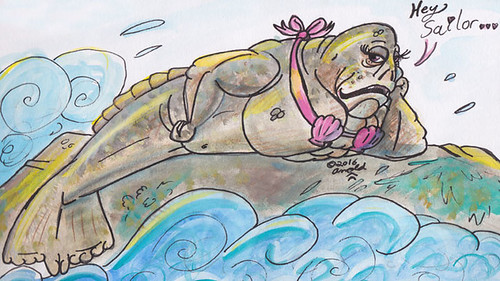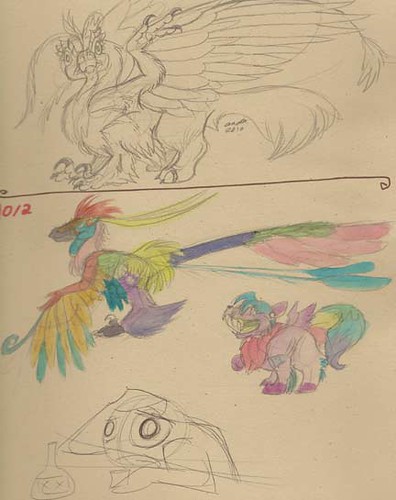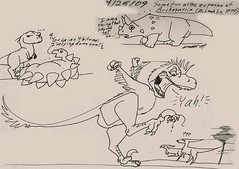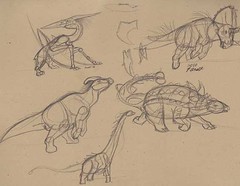Ah, Dougal Dixon. We've already explored his two signature books on speculative animals, and we've touched on some of his more obscure and incredibly strange science fiction biology works as well.
And I swore up and down that I'd never do a post about his Man After Man: An Anthropology of the Future.
This is all due to my first memory of sitting down and reading the book. I was young, innocent. I'd just devoured both After Man and The New Dinosaurs and I was ready for more. I found a copy of Man After Man, bought it, brought it home, and sat down to read it. And I was deeply, profoundly shaken to my core. It had upset me that badly. It upset me so badly, and remember this is preteen-logic at work here, I threw the accursed book into the recycling bin in the basement because I just could not stand having it in the house. So there's my glowing review of Dougal Dixon's Man After Man from some time shortly after it was first published in 1990.
Well, I am older now. I've read quite a lot of pessimistic science fiction and it doesn't shock me the way it did back then, so I am breaking that promise today! It's time! Get a strong drink and a comfortable seat! Do as I did and load up Sivatherium's archived edition of the book. Tune your radio to the very easiest easy-listening station you can find. (If the bioparanoia apocalypse has a soundtrack, it'd be even mellower versions of James Taylor and Amy Grant songs and the "St. Elmo's Fire" theme*.) Notify your next of kin, because all your most horrifying bad dreams are about to be lovingly painted in vivid, fleshy, body horror-y,
-y detail by Philip Hood. (Great day in the morning, this is a particularly epic Dixony Rolls Of Fat waking nightmare. You know the kind of sick feeling you get when you stumble upon somebody's uncomfortably specific fetish art? Yeah... 😨)
Humans are bastards! Everything is horrifying! God is dead and we genetically engineered Him away! Transhumanist body modification is either going to kill us all or make us into hideous mutants living in our own special Hell! Let's read Man After Man!
Bit of a side-note first. Tetrapod Zoology has written about Dougal Dixon's works extensively and I'd be remiss if I didn't direct you to this wonderful interview with Dixon. Man After Man has always had an uncomfortable place among Dixon's books, and this interview gives some hints as to why that might be: he really didn't want to make this book at all. Add to that the controversy of whether the creatures in the book were... *inspired*, let's say... by these Wayne Barlowe sketches and you've got yourself a book that could scream "I am a thing that should not be" as loud as the grotesque people who inhabit it's pages.
The book begins with an introduction by Brian Aldiss. It already sets a notably more dour tone than Desmond Morris' introductions to both After Man and New Dinosaurs. He talks about previous science fiction books that explored the possible futures of humanity, most notably The Time Machine, in which H. G. Wells depicted two different future species descended from humans. He supposes that Wells and his influences "would like this book, and be horrified by it: for we have, after all, traveled a long way since their day, and supped on horrors beyond their resources. We have lived through an age... when we have almost daily expected the world to be terminated."
Surely, we are in for fun times for all with this here book.
Dixon gives us a very quick review of how the process of evolution works and then emphasizes that we humans, with our penchant for unnatural selection and for modifying the environment to suit us rather than vice-versa, have effectively "broken" it. So then, how are humans going to change into the freakish mutants promised on the front cover? Simple: Genetic Engineering! This, indeed, may be one of the earliest instances of "genetic engineering is a new technology that is poorly understood and incredibly powerful and can probably do anything and is almost certainly going to end the world as we know it" in popular science fiction. That's something at least.
Next up is probably my favorite part of the book: eight million years of human history given in a series of short stories. This short-story format continues throughout the book, and that means where this book could have easily been a sort of freak show, instead it has an uncomfortable intimacy. In Dixon's previous books, the text was more like a dry field guide, but here we are invited into the lives of individuals. It's a subtle but particularly nasty way to remind us that no matter how strange the creatures in the book are, all of them, every single one, is a human.
The parade of body horror begins 200 years in the future and ends -quite abruptly- five million years later. Modern humans as we know ourselves survive for about another thousand years on Earth until the shifting of the magnetic poles wipes us out for good; we're simply too reliant on technology to survive that. Long before that, those who could afford to and who were deemed worthy went off to outer space to escape the ravaged Earth, in ships built, in part, by humans who'd undergone massive genetic engineering and body modification. Of these, Cralym the Vacuumorph is the most extreme and perhaps the most upsetting. She is a creature born to die, after serving her purpose of building the ships that will send her normal human parents to a new home. There is a question as to why people of the future would create such an extremely mutated human instead of, say, a machine, but this book has biotechnology as it's science fiction trope of choice and it's sticking with it. Anyway, Cralym's story sets the tone for the wild ride we're about to head on.
And all told, this is some darn good "Far out, man"-style science fiction. We meet the Mechanical Hiteks, cyborgs who are basically a brain in a box, and who are horribly vulnerable outside of their robotic vehicles. The Earth is starting to recover by their time, and so the Hiteks create new species of humans to take the place of the large animals that roamed the wilderness. The Hiteks themselves are succeeded by Tics, who live in what are essentially meat-mechsuits. Yup, fleshy bio-engineered meat-mechsuits with those good old Dixonian rolls of fat as far as the eye can see. They and the few remaining normal humans have the decency to die out, as previously mentioned, leaving the engineered new human species to their own agendas.
And oh we have such sights to show you. The Memory People are blessed and cursed with a "racial memory" that allows them to find rich sources of food but also essentially leaves them with "Koyaanisqatsi" running through their minds at all times; they voluntarily let themselves go extinct, lest they be tempted to become industrial humans again. Dixon's love of eusocial animals manifests in the Hivers, descended from humans modified to live on grasslands, they live in massive castles with a perpetually pregnant Queen (nope), and have a symbiotic relationship with a Seeker (nope), who starts off as a fairly normal humanoid with the psychic ability to find resources in harsh environments (what) and eventually evolves into a big-headed, limbless baby-thing the Hivers must carry around (nope). And there are the Tundra-people and Forest-people made kind-of-famous by this:
The Forest people are the most similar to the ancestors of all humans, which means that they are both the most adaptable and the most prone to being right little bastards. Once the technologically advanced humans are gone, leaving nature to take its course, they and the Tundra People diversify into the most bizarre mutants. One group of the Tundra and Forest people eventually become telepathic symbionts, all because a Forest person, driven mad by cold, tried to hunt a Tundra person like this and ended up sat upon -but not crushed- by their would-be prey. Sure. Another group of Tundra and Forest people became host and parasite, the Tundra person becoming a walking mountain of flesh to carry and feed nasty little vampire guys. At the four-million year mark things really get outright bonkers, with the Tundra people becoming "Sloth Men" who are preyed upon by Spiketooth descendants of the Forest people, who also give rise to specialized fish eaters (a dead ringer for the piscaverous ape in After Man) and, because this is a Dougal Dixon book, ant-eaters. This is all after Forest people have been shown to make and use tools, so I don't even know.
It's in the Year 5,000,000 and a half where everything goes to hell. This is probably the most infamous chapter of the book, where aliens invade Earth, enslave the mutants, mutate them even more horrifically into thoughtless biological weapons and living meat stores, and strip the land of all it's resources before blasting off again, leaving everything dead.
Did you guess who those aliens were? They were the distant descendants of the humans who left Earth millions of years ago! Woah! It really makes you think, doesn't it?
Fortunately, all is not lost, as there are people who survive the Apocalypse. Yes, the Aquatics! For my money, these mans after mans are the most... haunting. It's the eyes. And also the "mermaid tail" and the fact that we never really get an explanation of how it works, anatomically speaking. And the most of them, really. Anyway, these... merfolk... technically... they survive by camping out by the deep sea vents. It's implied that once the world recovers enough, these people will repopulate the planet, and it will be full of life again. So that's nice. I guess.
Thank you all so much for joining me on this journey through the world of Man After Man. I am going to have a lot of wine and a good long stare into space.
* - Sweet Christmas, somebody make a mostly straight remake of "St. Elmo's Fire" -- except all the characters are genetically modified affronts to nature. Dammit, I want to watch this hypothetical movie right now! I am so angry at myself for making myself want it so much!
-----
Art of the Day!
I am full of regrets...






















